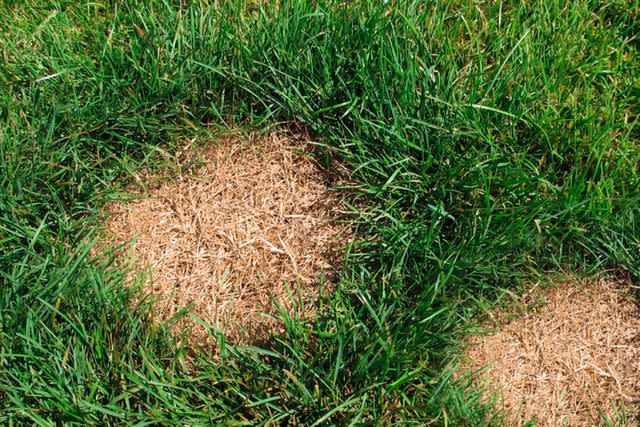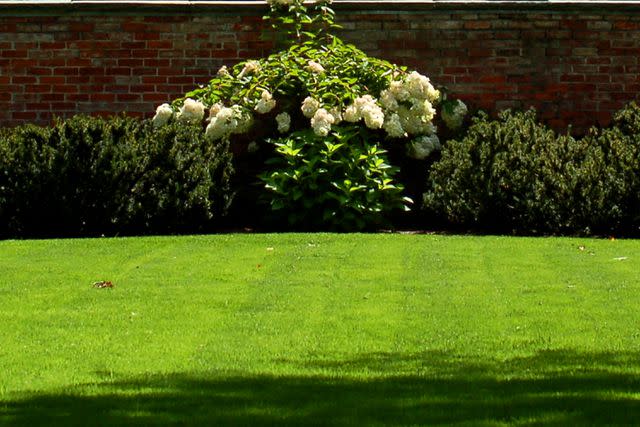How to Plant Grass Seed on an Already Existing Lawn

akurtz / Getty Images
Sowing seed to start a brand new lawn may be more exciting, but planting grass seed over an existing lawn at the right time is one of the most important things you can do if you crave the kind of lawn that turns heads. Referred to as "overseeding," it's a lot cheaper and easier than starting a lawn from seed.
While the overseeding itself is easy, the preparation and the aftermath involve some steps that may not be obvious to beginners. Learn the right way to perform all the steps in planting grass seed on an already existing lawn.
What Is Overseeding?
Overseeding is sowing seed over existing grass to optimize lawn performance. It is related to, yet distinct from, sowing seed to repair a bare patch.
Reasons for Planting Grass Seed Over an Existing Lawn
Depending on your goals, needs, and where you live, there can be different reasons for planting grass seed over an existing lawn. It can be used to:
Revive a struggling lawn
Prevent a healthy lawn from lapsing into decline
Provide (in the South) a temporary lawn in winter while your warm-season grass lies dormant
Tip
Stay away from using pre-emergent herbicide on your lawn in spring if you're going to overseed because the herbicide will nullify your seeding efforts.
Regardless of why you're overseeding, the project can be divided into three stages: preparations, spreading the seed, and caring for the seed/seedlings afterward
Overseeding Preparations for a Struggling Existing Lawn
There are many reasons for a struggling lawn including foot traffic, failing to mow grass at the proper height, or letting thatch buildup go unaddressed for too long. Other times, though, it's not something in our control: lawns just get old and lose the ability to replace dead grass, causing gaps to form.
Here's how to prepare for overseeding a lawn in such cases:
Preparations
Since the lawn is struggling, more attention is required before you can overseed. Depending on the reason for your lawn's struggles, you may need to do any or all of the following:
Mow the existing grass shorter (1.5 to 2 inches tall) than normal so that the seed gets more sunlight.
If the topsoil isn't very deep on part of the lawn due to shallow tree roots popping up there, add 1/4 inch of topsoil. Don't add more than that: piling up an excessive amount of soil on such roots is bad for the tree's health.
Have your soil tested in case it's lacking in nutrients or has an incorrect soil pH. As part of the testing, your county extension office will tell you what (if anything) you need to do to improve the soil.

The Spruce / K. Dave
Overseeding Preparations for a Healthy Existing Lawn
If your lawn is healthy, you may think you don't need to overseed, but overseeding can help give you an even thicker lawn, improve your grass quality, and fill in any bare spots. It can also help your lawn's ability to fight off pests and diseases, which is necessary to keep your lawn looking healthy longterm. Even if your lawn is in good shape, you should look to overseed one to two times per year. Your preparation will consist mainly in mowing the existing grass shorter (1.5 to 2 inches tall) than normal.
However, two considerations precede even the preparations discussed so far:
Deciding what's the right time of year to overseed
Choosing the best grass seed for the job
Fall is the best time for this kind of overseeding with cool-season grasses. By sowing their seed in the fall, the seedlings still have time to become established before winter sets in. Then, in spring, the seedlings have another few months to get further established before the summer heat sets in. But in the South, overseed in late spring, just when the warm-season grasses are starting to grow actively.

Overseeding Preparations to Provide Winter Color on an Existing Southern Lawn
Southerners, knowing that their warm-season grass is going to turn brown in winter, often seek a way to maintain a green lawn even when cold weather comes. Since cool-season grasses are plenty cold-hardy to stay green through a Southern winter, all you have to do is overseed your lawn with cool-season grass. This is best done in the fall.
To fully understand why this will work, you first need to understand the distinction between cool-season grasses and warm-season grasses. Essentially, cool-season grasses thrive when it's cool (spring and fall), are cold-hard, and perform better in the North. Warm-season grasses like it hot and are able to withstand the summer heat, making it the ideal grass type for warm, Southern regions. Cool-season grasses may go dormant in summer when it gets too hot and dry; warm-season grasses go dormant in winter.
The concept is straightforward enough: the cool-season grass takes over temporarily in providing color, then it dies and gives way to the warm-season grass again when the weather heats up.
If overseeding with annual ryegrass, you'll need to do so every year as it only has a one-year life cycle. Perennial ryegrass will come back year after year, however, you may still want to reseed in the fall as it may not come back evenly and you may find yourself with clumps and bare spaces.
Preparations
Mow the lawn.
Choose a cool-season grass seed.
A popular grass for such purposes is ryegrass. You can choose between annual or perennial ryegrass based on your own quality and growth preferences.
How to Plant Grass Seed on an Existing Lawn
Now that you know how to prepare for the job, learn what to do in stages two and three of the project.
Plant the Seed
Set your spreader to the overseeding rate stipulated on the seed bag.
Load some of your grass seed into the hopper.
Spread the seed across the lawn.
After-Care
Immediately after overseeding, apply a starter fertilizer.
In spots where quite a bit of bare earth is exposed, lay down a thin layer of straw to keep birds from eating the seed.
Using a fine water spray, water the soil to keep it evenly moist, not only during the germination period but also while the seedlings are still young.
It's okay to mow, but don't walk on the grass more than you must.
Apply a quick-release nitrogen fertilizer five weeks after your grass seed has sprouted (repeat in another six weeks).
Read the original article on The Spruce.

